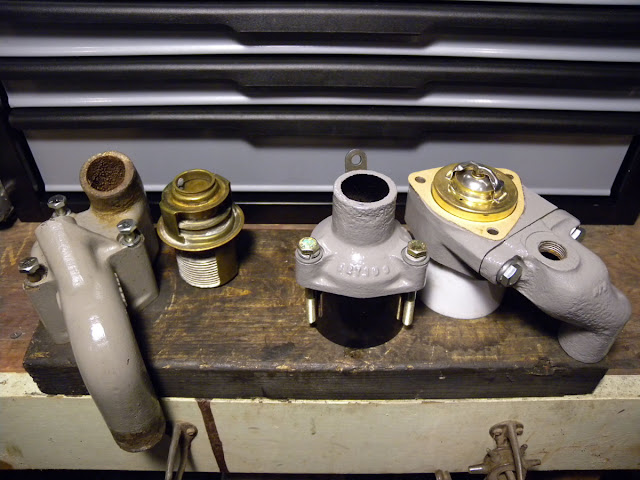Further testing of the old thermostat showed that it could stick shut from time to time. A look at the coolant system design also appeared to show that the large Kodiak heater hoses were likely bringing a lot of coolant directly back into the engine, coolant which doesn't pass through the radiator.
At first I tried to find a new thermostat, to see if that would cure the problem, and while I eventually found one, they are obviously very hard to come by and subsequently quite expensive. This rarity might pose problems in the future. That, and the Kodiak hose question, made me look at the later thermostats used on Series 2a and Series 3 vehicles.
Those designs (there are two types) looked as if they might have some design advantages over the original, and after some more research, the late 2a/3 type looked best. It's thermostat has a 'skirt' that blocks a large part of the flow back into the engine, the rest then going through the radiator. It also has a 'cap' that, when the engine is cold, appears to stop flow to the radiator more thoroughly and direct more coolant directly back into the engine until the engine has warmed up.
The earlier thermostat, which didn't seem as effective, is a 'waxstat', with the same permanently open hole at the top as with the bellows type, which means more coolant going immediately back into the engine without passing through the radiator. The open thermostat doesn't do that much to divert flow to the radiator except lack of resistance down the radiator channel, which is offset from the main channel.
The newer housing installs without a problem onto the older type cylinder head. I installed an 82C thermostat (the other option is 74C), went for a long drive, and the engine, once at full operating temp, stayed at 82C. Right on the money. It would seem the problem is solved.
Below, the original 1960 housing. Note how the radiator return-hose empties directly back into the engine. It still does with the new housing, but the thermostat and housing design directs far more coolant to the radiator, and appears much better able to cope.
On the left, the original housing and (rare) bellows-type thermostat. On the right, the new housing with skirted thermostat and gasket in place. (Parts are sitting on spray can lids, in case you're wondering.)
On the left, the skirted thermostat and outlet housing. On the right, an earlier waxstat outlet. Note the differences in the openings. The inset image is just there to show the waxstat shape, as I don't have one here.
New housing and thermostat in place. It would seem much simpler to change thermostats with this design, too.
Have re-routed the heater return-hose to the side of the engine away from the exhaust manifold, too, in case that helps cooling by keeping the hose away from a hotter part of the engine.
Just needing the fan shroud to go back on, once another test drive confirms there are no leaks.
Finally, after a long test drive, fan shroud re-installed, and heater hose attached to center bolt of the valve cover with an aviaton hose clamp, to stop the hose touching the ignition wire or valve cover.








Great instruction. I did the same on my 1958 Serie II Typ 151 engine. I even had a fourth type of thermostat build in, but it didnt work well either. I switched to the 2A version, as you did. Cheers, Lukas
ReplyDeleteFor your information the thermostat top housing you refer to as a waxstat housing (on the right in your third picture showing the two top housings side by side) isn't for a waxstat type thermostat as illustrated by your inset picture, but for the earlier bellows type thermostat (part no. 504736) with skirt for bypass control.
ReplyDeleteWhilst a waxstat thermostat will fit the hole, it won't perform the correct job of controlling the bypass circuit flow and engine cooling will be compromised as a result.
The correct solution is as you have done, to source the skirted thermostat and appropriate later style top housing (part no. 527109) to maintain correct cooling system functionality. Lovely job you have done on your Land Rover.
What color did you use, Iv'e heard these early engines were grey, other people say the duck egg blue (aka light admiralty grey) was correct, even for these early engines. In fact, i even had someone tell me green was correct.
ReplyDeleteYes, the early engines (approximately to the end of the Series 2, but extending into the 2a) were grey. After that, they were Duck Egg Green. It's usually possible to tell what colour an engine was originally by examining pristine areas beneath or between parts, etc.. The paint that most closely matched my engine is by Devguard, type #4338, a deep base urethane alkyd enamel, and the colour is Mansard Stone. A very good, tough paint that dries without brush strokes.
DeleteHello,
ReplyDeleteI'm not sure if there is a way to contact you directly. I have the same year and spec. truck and have a few questions about a few other things.
Thanks, Paul
Having the right HVAC contractor is important when you're experiencing issues with your furnace or air conditioning system. At Ultra Air Heating & Cooling, we handle all kinds of HVAC projects in Raleigh and the surrounding areas. We value our customers' time, so we'll be there when we say we will. We can take care of anything from repairing air ducts to installing a new furnace, and our professional technicians will put their skills to work and finish the job promptly. We want our clients to be satisfied with their complete experience, and we start by delivering excellent service.
ReplyDeleteAddress: 3200 Lake Woodard Dr, Suite 106 Raleigh, NC 27604
Phone Number: 919-348-9399
Email: ultra.jhughes@gmail.com
Website: https://www.ultraairhvacnc.com/
Are you able to post the part numbers for the new thermostat housing you installed?
ReplyDelete